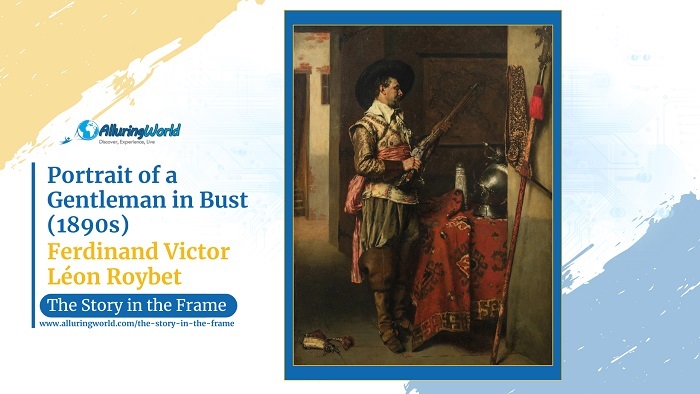The Portrait of a Gentleman in Bust by Ferdinand Victor Léon Roybet is an exquisite example of the artist’s ability to capture nobility and refinement through portraiture which was painted in the late 19th or early 20th century, as the exact date is still unknown. Known for his detailed depictions of historical figures, Roybet brings his subject to life with masterful attention to fabric, expression, and atmosphere, and this painting reflects the elegance and sophistication associated with aristocratic and upper-class portraiture, showcasing the sitter’s wealth, status, and personality with remarkable finesse.
About the Painter:
Ferdinand Victor Léon Roybet (1840–1920) was a French painter renowned for his historical genre paintings and portraits, often inspired by 17th- and 18th-century European nobility. Originally studying at the École des Beaux-Arts in Lyon, he later moved to Paris, where he gained recognition for his meticulously detailed works and his paintings often featured rich, opulent textures, elaborate costumes, and dramatic lighting, making him one of the most sought-after portraitists of his time. His ability to capture the grandeur of past eras while infusing his subjects with individual character set him apart in the art world.
Inspiration and Reasons Behind the Painting:
Roybet’s fascination with the nobility and historical themes greatly influenced his portraiture. His works frequently depicted aristocrats, military officers, and dignitaries, reflecting an idealized vision of wealth and power, and the Portrait of a Gentleman in Bust aligns with this tradition, serving as both a tribute to the grandeur of the past and a representation of the subject’s prestige. The choice of attire, the confident posture, and the striking use of light all emphasize the social importance of the sitter, showcasing Roybet’s skill in blending realism with a sense of romanticized history.
What is Depicted in the Painting:
The portrait features a distinguished gentleman, depicted as a whole figure and dressed in formal and possibly period-inspired attire in a small room where usually weaponry of the time was being kept. His expression is poised, conveying wisdom, authority, or quiet confidence, however, the details in his clothing—such as embroidered fabrics, lace collars, or military insignia—suggest his high status, possibly being a nobleman, scholar, or military figure. The background is likely muted or dark, a technique often used by Roybet to enhance the subject’s prominence, allowing the viewer to focus entirely on the sitter’s features and expression.
Colors and Techniques:
Roybet’s use of color in this portrait is likely rich and deep, with luxurious tones of gold, deep reds, and warm browns creating a sense of refinement. His mastery of chiaroscuro—strong contrasts between light and dark—enhances the depth and realism of the figure, making the subject appear almost lifelike, and the textures in the painting, from the softness of fabrics to the sharpness of facial features, demonstrate Roybet’s careful brushwork and attention to materiality. His style, reminiscent of Old Masters like Rembrandt and Van Dyck, adds a timeless elegance to the composition.
Conclusion:
In conclusion, Portrait of a Gentleman in Bust is a striking example of Ferdinand Victor Léon Roybet’s skill in historical and aristocratic portraiture. His ability to capture both the physical likeness and the underlying character of his subjects made him one of the most accomplished portraitists of his time, and this painting not only preserves the grandeur of a bygone era but also continues to captivate viewers with its attention to detail, rich color palette, and timeless elegance.

